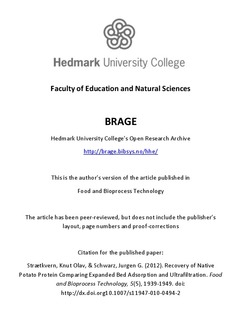Recovery of Native Potato Protein Comparing Expanded Bed Adsorption and Ultrafiltration
Journal article
Permanent lenke
http://hdl.handle.net/11250/134506Utgivelsesdato
2012Metadata
Vis full innførselSamlinger
Originalversjon
Strætkvern, Knut Olav, & Schwarz, Jurgen G. (2012). Recovery of Native Potato Protein Comparing Expanded Bed Adsorption and Ultrafiltration. Food and Bioprocess Technology, 5(5), 1939-1949. doi: http://dx.doi.org10.1007/s11947-010-0494-2 10.1007/s11947-010-0494-2Sammendrag
Obtaining native protein from potato fruit water
(PFW) acceptable for food consumption was attempted by
comparing expanded bed adsorption (EBA) and ultrafiltration
(UF).The methods were assessed on their process performance
and the product quality. Extractable tuber proteins
were recovered from lab-prepared PFW either by adsorption
to an EBA column using a mixed mode resin (0.31 L) or by
batch concentration in an UF (10 kDaMWCO, 0.093 m2) unit
and then freeze dried. The yields on protein and esterase
activity were higher (p<0.05 and p<0.01; Mann–Whitney
U-test) in UF (3.2 gl−1 PFW and 3.17 kU l−1 PFW) than in
EBA (1.8 and 1.21). The performance difference was also
reflected in process productivity for esterase activity which
was fivefold better (p<0.01) in UF (4.30 kU h−1) than with
EBA (0.84) due to the higher enzyme retention; protein
productivities were the same. The content of solanidine
glycoalkaloids was depleted to moderate levels but came out
unaffected by the processing method: EBA 286 ppm, UF
213 ppm. The low levels of chlorogenic acid in all EBA
preparations were negatively correlated to high brightness
score (L*=73.8%), a favorable attribute in food-quality
proteins. Both methodologies produced native preparations
of comparable protein content (75%). EBA processing, however, increased the fraction of the patatin protein which
may offer advantages in food applications.
Beskrivelse
This is the postprint version of the article published in Food and Bioprocess Technology. The published article is available at www.springerlink.com
